ChopperTalk: Where America's Top Political Journalists Go to Get Abused by the World's Most Powerful Man
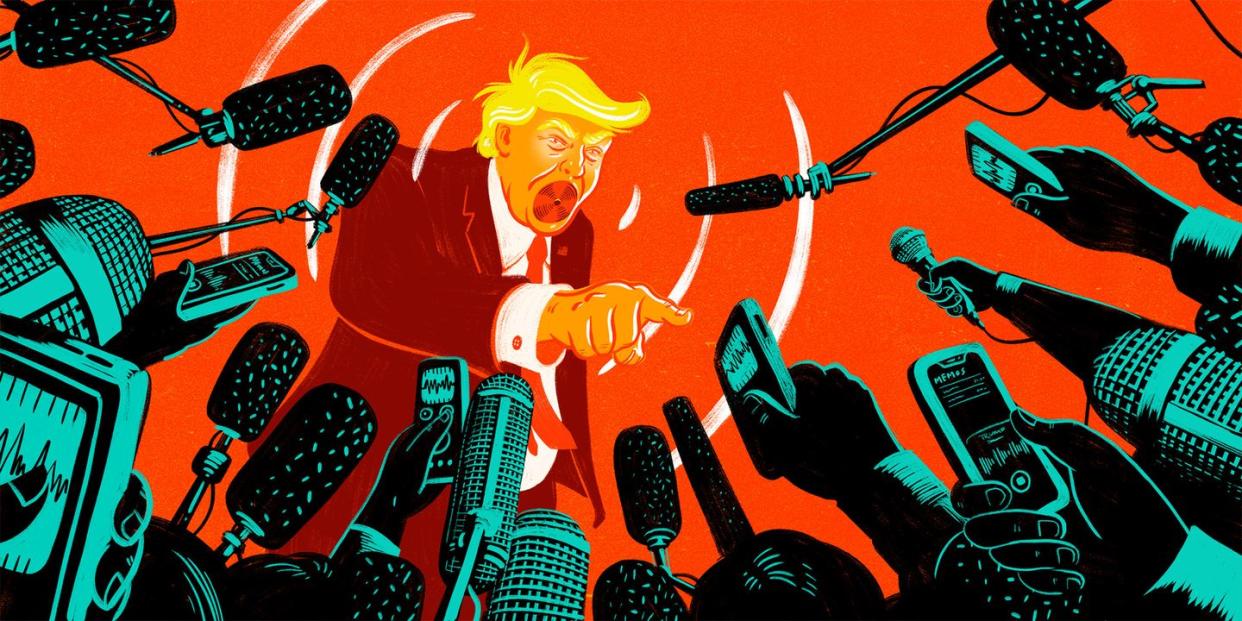
“We’ve got a fresh Diet Coke,” the cameraman announced, peering through the lens at President Trump, who was locked in conversation inside the Oval Office. “Beverages were just served.” The White House press corps erupted in groans. It was getting towards an hour since we’d been marched out to the edge of the South Lawn to wait for the president. The cameraman, zooming in on the window, informed us that the other guy was Attorney General William Barr. Outside, the crisp fall dusk was punctured by the metallic roar of a helicopter engine. The soft drinks were a grave portent: they signaled the meeting would stretch on, which it did, as the sun dropped in the cold November sky. We would have to wait a bit longer for the chance to ask the President of the United States a question over the almighty din of the helicopter stationed 50 yards away. We would have to wait for ChopperTalk.
When the president has a flight to catch, he jumps on Marine One—the call sign for any Marine Corps aircraft the president is on, but which is normally a green-and-white VH-3D with “United States of America” stamped on the side—and heads to Andrews Air Force Base to meet Air Force One. Historically, this departure has mostly been an event for photographers, White House tour groups, and anyone else who might be struck by the visual experience. The president would stride out, wave at the small crowds, and climb on-board. Occasionally, he would stop and take a couple questions along the rope chain, but it was a rarity.
Not anymore. In the brave new world of the Trump White House, where there has not been a White House press briefing in over eight months, ChopperTalk is among the only opportunities members of the press have to question a principal member of the administration. And around three out of four times, members of the White House press told me, he’ll come over to take questions. It has become an essential event.
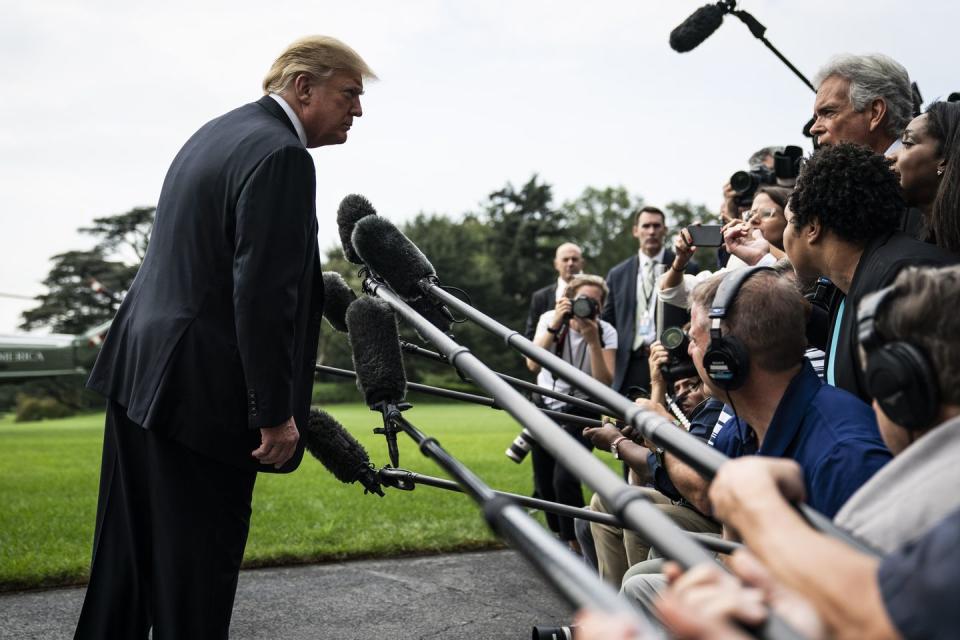
The White House press are people who have reached what has traditionally been viewed as the pinnacle of American political journalism, waiting—and jostling—to ask the president a question no one can hear over the deafening hum of Marine One, only for him to yell about whatever the hell he wants and ignore attempts at a follow-up question. Sometimes, Trump will spot someone he considers an enemy of the state and jab a finger in their direction while saying the magic words: “You’re Fake News!” On television, it appears as if the president is up against a pack of faceless jackals, baying at him for a quote. If it’s become essential, it’s also become something of a farce.
“You haven’t lived,” said Brian Karem, the senior White House correspondent for Playboy known for getting in a few tiffs at the White House, “until you’ve been crammed with 175 people into a space meant for 25.” He was exaggerating, but we really were packed in like sardines. The scrum stretched four rows deep this time, but it’s often bigger than that. Everyone leans in to get a better view, stretching out an arm to get a question in. The president, meanwhile, stalks back and forth on the other side of the rope-chain, surveying the havoc.
Karem recalled an early incident in which the president was returning from a trip, headed to a White House event where he would serve a champion sports team some fast food. There was a layer of snow on the ground, the air was bitterly cold, and when the chopper arrived, it sent all of that blasting towards the crowd of reporters. It was chaos as everyone tried to shelter themselves from the storm, and that was before the president disembarked and walked right by the scrum, headed straight to the West Wing. At that point, all hell broke loose. People made a run for it trying to catch the president before he got inside. Some people fell. Karem claims to have “pole-vaulted” over one of the bodies strewn about and, in a gruesome victory, was the only reporter to get close enough to Trump to ask him a question before he got inside.
“Mr. President, do you still own the [government] shutdown?” Karem asked, zeroing in on the deranged Trumpian folly du jour.
“I’m glad you asked that,” the president responded, pointing at Karem as a devilish grin crawled across his face. “We’re getting these young men some Chick-fil-A and McDonalds.” Then he opened the door and went inside.
There are a number of canonical terms for this semi-regular program produced by and starring the president. “ChopperTalk” was popularized by Stephen Colbert, who has a recurring segment under that name, though Karem claims to have coined it in a column. (Early on the first day I spent with White House press, he burst into the James S. Brady Briefing Room and, channeling the voiceover from a G.I. Joe commercial, announced, “Today, we’ve got a...CHOPPERTALK!”) But some of the regular victims refer to them as HeliConferences, or RotorRants. The last is a bit of a misnomer, however: the rotors actually stop spinning soon after Marine One touches down. It’s the motor that keeps running, and burning fuel, while the president hollers that you’re really going to love what we’re doing with respect to China. There’s no point asking whether this routine is productive from a fiscal or environmental standpoint. Forget it, Jake. It’s ChopperTalk.
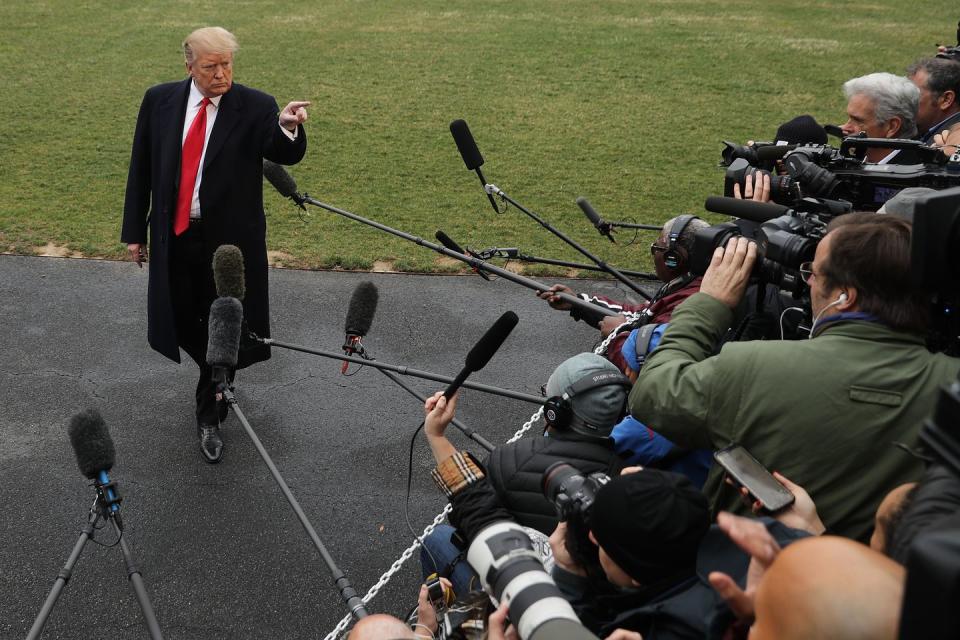
Whatever you want to call it, this is the physical manifestation of the Trumpian id and everything it demands from the world around him. The guy who spent his early adulthood calling up People magazine under a false name to offer details of Donald Trump’s rip-roaring sex life is now the most famous person in the history of the world. He always wanted his name in print, but more than that, he wanted the cameras pointed at him—and him alone. That is what he gets out of ChopperTalk: the Wall of Cameras, the visceral sense that the whole world’s eyes are trained on him. Correspondents that Trump watches on TV—for four to eight hours every day—are leaning and elbowing and craning their necks to get his attention. A photo taken from his vaunted perspective hangs in the West Wing, off the Briefing Room, just to drive the point home. The wall of cameras is a Trumpian dream. For the Very Fake News, it’s a bit of a nightmare—which is itself an essential part of the Trumpian dream.
The prevailing sentiment from White House journalists is that it is horrible. It’s bad in the winter, like in Karem’s horror story, but some told me it’s worse in the summer heat. You’re packed into a rugby scrum, waiting and sweating, the D.C. swamp heat beginning to set into your every pore. People get testy. A few weeks before my ChopperTalk experience, according to one of my new colleagues, one reporter made the mistake of raising his phone to take a photo of the president and blocked the pool camera, which supplies video for all the networks, in the process. The cameraman slapped the phone out of his hand.
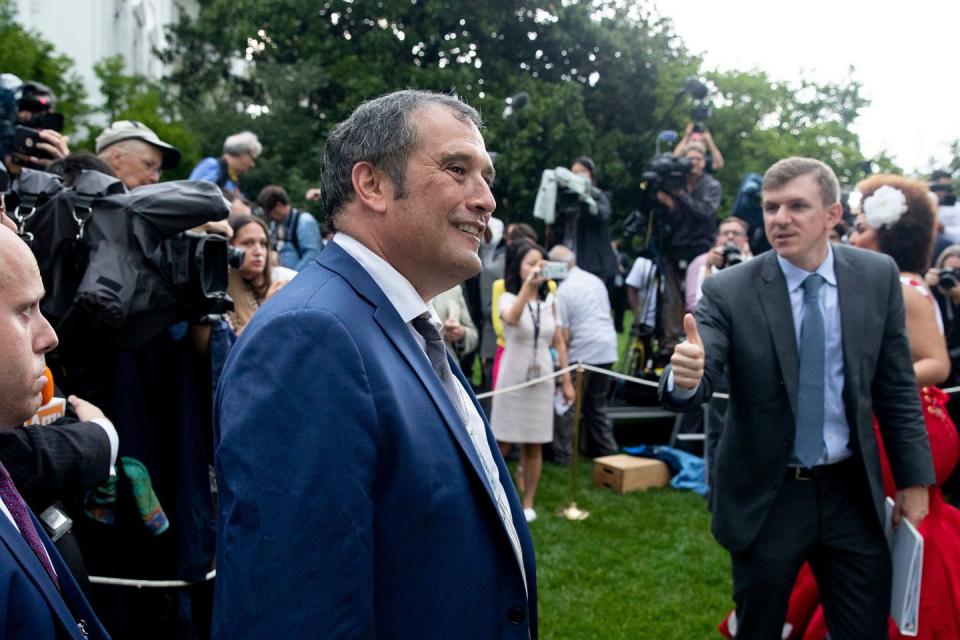
Reporters are also competitive beasts by nature, and there are plenty of shenanigans around securing a prime spot to get yelled at by the world’s most powerful man. The current pre-show process is apparently the product of an evolving set of rules after constant dysfunction with prior iterations. (In the early months of the administration, reporters told me, it was the Wild West, with reporters and camera operators chasing White House officials around the grounds—and often taking spills in the process.) White House staffers will occasionally ask for feedback on how the process could be better. “What if,” a senior reporter mused, “there were a room, inside the building, where all the networks could set up their cameras and everyone could hear the questions that were asked?”
The new system begins on the other side of the White House building. “You’ll see everyone lined up here,” a senior White House reporter told me earlier in the day, pointing towards an area outside the White House Briefing Room. “It’s kind of embarrassing.” (Most reporters weren’t interested in speaking on the record, presumably for fear things could get still more unpleasant for them, even if they mostly downplayed the notion their lives were particularly hard.)
There are four different lines, designed to have people file in based on how important they are and how tall. The goal is to create a kind of stadium seating, though it isn’t always successful. In the front, sound people hunch on the ground. Then there’s the “pool,” a smaller circle of the press corps whose members rotate, and who accompany the president at times when the whole group can’t. They report back to the rest of the group what happened, and in effect keep the record for everyone assigned to the White House. There are the writers and correspondents, too. Then there are more cameras, who get up high on mini-ladders. The new process is only a month or so old, but folks are already taking liberties. They’ve started to leave stools with their outlets’ names on them to stake out a place hours in advance, a workaround for the rule stating you can only line up 30 minutes before the call time. Ahead of the ChopperTalk I attended, people formed a fifth line in between the second and third lines and ended up cutting the latter, at which point the third-line people joined the fifth line.
In the end, we all kind of just went for it. We filed into the White House lower level, through the Rose Garden and out onto the South Lawn. There was no helicopter yet, but rope chains had been assembled along an asphalt path. There was no running this time—I was told that, when the crowd is bigger, there’s at least some Olympic fast-walking—and when everyone assumed their positions, a kind of camaraderie set in. It felt like we were all about to take a particularly difficult chemistry exam, one in which the proctor berates you throughout as a real low-life. I found a good place behind the pool camera, and a reporter with less of a view asked me to let her know as soon as the president was coming out. We passed along a cable to connect a cameraman with a colleague. The sun was shining. Jostling was minimal. A few people started to take over-unders on when our fearless leader might emerge.
Marine One came in low a few minutes later, sweeping over the South Lawn and swooshing the water of the fountain in the middle ground ahead of the Washington Monument. The green machine zipped over to land about 60 yards from the White House building, but as it eased into touching down, the gale-force waves of autumn air it whipped up sent an Arctic chill and plenty of projectile leaves hurtling towards the press corps. Some of the nation’s most prominent political journalists ducked and huddled together amid the swirling artificial tempest. After a minute or two, the rotors stopped, and all that remained was the growling whirr of the motor.
It was an almost violent intrusion on the scene. The presidential manse and the surrounding grounds are, after all, blessed with breathtaking beauty. The sun began to set in the cloud-rippled sky, the yellow giving way to orange and red, and then a soft pink. The autumn leaves rustled occasionally on the trees, and a bird flapped about in the foreground with the fountain and the Monument looming behind. But as the minutes dragged on, despondency began to creep in. The sun dropped behind the Eisenhower Executive Office Building, and then the dam really broke. Gallows humor started. Soon enough, talk began that maybe the president wouldn’t even stop and chat—he’d just head straight to boarding. Earlier in the day, Karem told me he’d once said something similar during a particularly trying ChopperTalk runup. A colleague turned to him and said, in complete solemnity: “Don’t say that. Even in jest.”
Despite the obvious kick he gets out of all this, I was told that up until recently, the president was usually close to on-time for these spectacles. If the public schedule said he was set to depart at 4:10 p.m., as he was here, he’d be up and headed towards the chopper around then. But we were nearly an hour in now, and the sun was gone, and the cold started to creep up from the asphalt. Finally, the attorney general got up and left—only for a new group, including White House Communications Director-slash-Press Secretary Stephanie Grisham, to trickle in. “There’s a new meeting that’s beginning,” announced Peter Alexander of NBC News. The group groaned again.
“If you get the chance to ask the President of the United States a question, you take it.” That was one correspondent’s response when I asked him why they all continue to put up with this, week after week. Every reporter who waits in line to get marched out to wait some more, until finally the president comes out to explain that we’re looking at that very seriously, and people are talking about it more and more, knows why Donald Trump likes ChopperTalk. It’s difficult to hear reporters’ questions, making it hard to know when Trump dodges them. They can’t ask a follow-up if he lies or misrepresents things in his response. And most of all, he can prowl back and forth along the rope chain, picking and choosing who gets a question.
He tends to favor people he recognizes from the television screen, from which he gets the vast majority of his information about the world, and through which his entire presidency is continually being filtered back and forth. With the exception of The New York Times, a print reporter from another outlet said, Trump doesn’t really know anyone from print publications, and they’re rarely called on. Sometimes, if there’s a foreign reporter in attendance, he’ll call on them to mix it up. But most of all—and this is true of his more traditional pressers, too—he likes to call on friendly faces from Fox News and One America News Network, the channel for people who think Fox News is insufficiently pro-Trump. The president is, at times, one of those people.
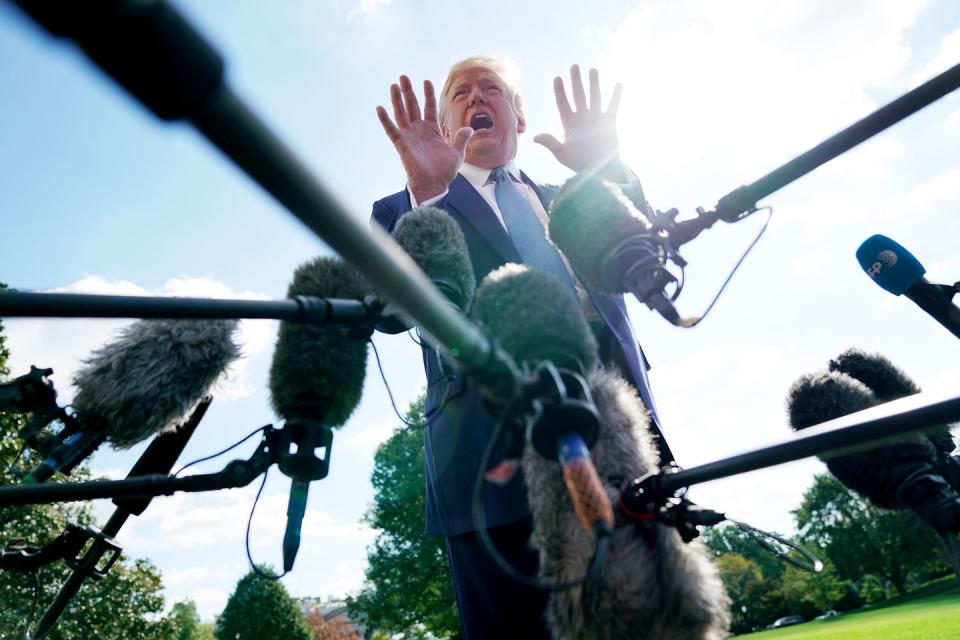
Trump and his staff like to say he’s the most accessible president in history, or some variation of that. He does still take questions at bilateral press conferences with visiting foreign leaders. Occasionally, like on the Friday following this ChopperTalk, the press pool will be allowed to ask a few questions at an event where he’s speaking. But the daily press briefings are gone, and Press Secretaries Sarah Huckabee Sanders and Stephanie Grisham have justified this on the basis that reporters just want to “showboat” and get on TV. However, some in the press corps believe Trump never liked watching someone else speak on his behalf—and with the camera trained on them. In fairness, it never meant much when any press secretary made a public claim anyway: the president was liable to contradict it by the next morning. Trump himself has ventured into the Brady Press Briefing Room just once, a surprise visit where he took to the lectern with four bald guys behind him and a highly visible spray-tan line on his face. (Some White House reporters speculated that he came by because Nancy Pelosi had been sworn in as Speaker of the House earlier in the day—and was hogging all the headlines as a result.) Pretty much every other event he does is with a friendly audience. They are staking a large part of this claim that he is so historically accessible on the ChopperTalks.
“It’s faux access,” said a senior White House reporter who has mostly stopped participating. “It’s a joke.” Some colleagues agreed, but others simply saw it as part of the job as it now exists. The president is under no technical obligation to give anyone access at any time, though there used to be some expectations in a democratic republic. And presidents do tend to choose favorable ground on which to engage the press. President Obama, for instance, liked to sit down with local news outlets who might be a little more taken with their surroundings than jaded White House beat reporters. He also liked press conferences in the East Room, one reporter told me, presumably because he saw some advantage in the gold curtains and the chandeliered high ceilings. The Briefing Room is less grand and imposing, and it’s familiar terrain for the questioners.
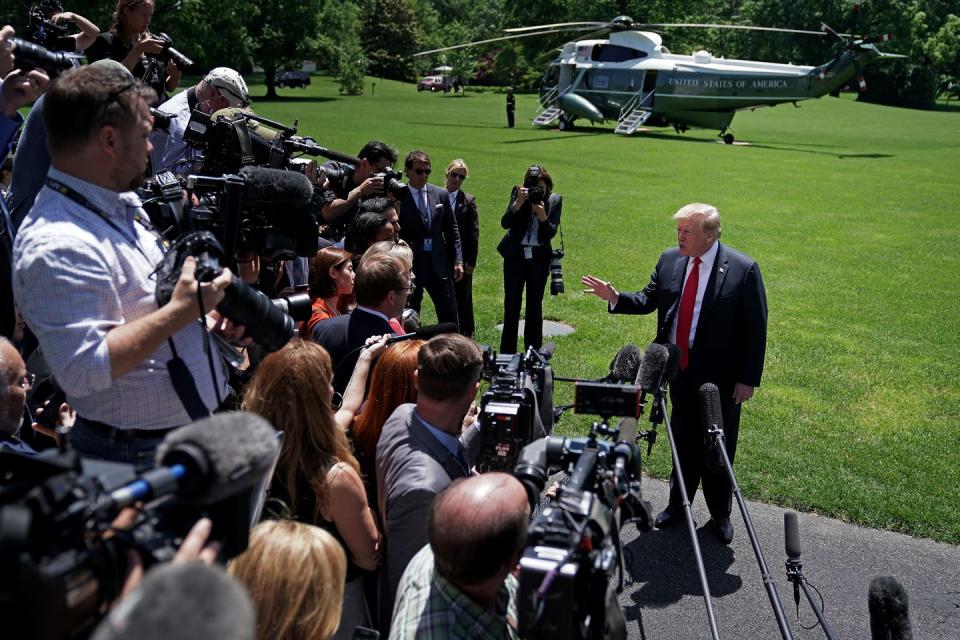
But this comparison only goes so far: Reporters in the Obama White House could more easily ask follow-up questions and push back on the president. Obama would also occasionally stop by the Briefing Room. Most importantly, though, press obfuscation was not part of the larger pattern of that presidency, whereas Trump has engaged in a ritual abuse of the press—not just to damage their credibility with his followers, but also as a spectacle in itself. The Fake News Media is on the list of Enemies waiting for a smackdown, right after the greatest heel there ever was, Crooked Hillary.
I suggested to a group of reporters, including Karem, that the ChopperTalks might be emblematic of Trump’s relationship with the free press generally: combative, cacophonous, performative, with a total disregard for truth, accountability, or even a minimal level of decorum. “It’s emblematic of who he is,” Karem said. “He wants us packed in so we look like animals, but when he’s stalking around like that, he’s the animal.” It’s no coincidence that the press are packed into “pens” at the president’s rallies, too. But his relationship isn’t this simple: it’s about more than just turning national political reporters into zoo animals. Previous administrations complained about their media coverage, but they also still allowed themselves to be subjected to critical voices. Sometimes, they changed course—even slightly—based on questions and conversations with the press, who, lest we forget, represent the public, even if the public isn’t always satisfied with the representation. This president, meanwhile, is determined to surround himself with Yes Men. Dissent is considered a personal affront, and the echo chamber makes for worse policy.
The day after our trip out to the South Lawn, Donald Trump held an event on “Honesty and Transparency in Healthcare Prices.” I was free to giggle at this because only the pool was allowed in the room for it. They grouped in the Briefing Room near the sliding door to the White House press office, chattering a bit until an aide had them file out and upstairs to the event. It was shown live on the monitors in the Briefing Room. The president gave his speech and then offered up some time for questions, many of which focused on the ongoing impeachment proceedings against him, which he in turn greeted with vitriol. This came to a crescendo with the last question: “Mr. President, do you think you’re going to get impeached?” After some rambling about the Louisiana governor’s race and The Transcript and Devin Nunes, he got to the heart of it:
Look, if we had an honest press in this country, we would be so well served. And you know what? When I look at your approval numbers, they’re the worst they’ve ever been in the history of our country. The media, the approval numbers—they are horrible. And you ought to get yourself back and you ought to put yourself back in a position where people respect the media again.
And I know some great journalists, I know some great people in the media, but there aren’t enough of them. There’s a lot of dishonesty. And many of you, I just consider members of the Democrats, and it’s a shame. Okay. Thank you all very much. Thank you.
Soon enough, the pool filed back into the Briefing Room and were greeted with faux jeers from their colleagues. “Boo!” said a network cameraman behind me. “Fake! You’re fake! You’re all Democrats!”
“My poll numbers look terrible,” said one member of the pool.
“I wear my heart on my sleeve,” said another. “All I want is bad things for the American people.”
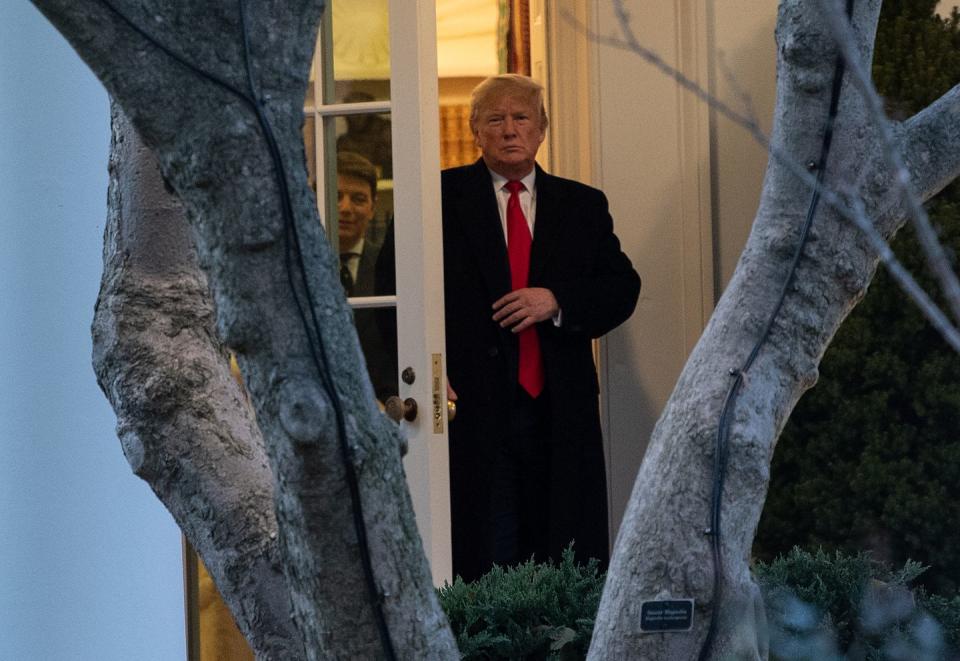
This is daily life for journalists who work at the White House now, some of whom are highly paid on-air correspondents or snazzy New York Times scribblers with a CNN contributor contract. Others, however, are camera or sound guys, or reporters working at small outlets for not-great pay. Folks in that last category will tell you the White House Correspondents Association does little to represent them, which is part of why the current state of affairs persists. They exercise little power within the organization, where the major networks and newspapers hold sway. (One reporter for a small outlet described his futile efforts to get in the rotation for the pool, which he quickly learned was reserved for the big boys.) The ChopperTalks are necessary if inconvenient for the TV outlets, who need sound and video to fill air later in the day, and who get called on more frequently. These spectacles have replaced the press briefings as footage for the evening newscasts. The networks have essentially decided to take what they can get from a hostile White House.
In truth, the WHCA would have a hard time organizing the press corps—a herd of cats—even if its members did not have different incentives, and were not competing against one another. It was the same when Ron Ziegler was tormenting the corps on behalf of Richard Nixon, as Timothy Crouse so memorably illustrated in The Boys on the Bus. For some, it’s not so easy to accept the status quo, but they don’t have much of a choice. Everybody needs to file a story at the end of the day. Everybody’s got an editor or a producer who expects them to throw something together. Besides, even if you successfully organized some kind of boycott, some scab would just take your place and ask the president a question. OANN isn’t joining your protest. If you have the chance to ask a question, you ask a question.
After over an hour of waiting to do just that, there was a breakthrough. You could see it with the naked eye as Trump rose from his seat and headed towards the door and his advisers filed out another way. “Is he coming out?” asked a shorter member of the group, who couldn’t see but could sense something. Suddenly, there was a burst of energy in the scrum and a flurry of activity. People readied their recorders, swiped to open the cameras on their phones, and whipped out their pads and pens, having kept everything, including hands, in their coats amid the sharp freeze that had set in. Everybody inched forward a bit towards the rope chain. It was go time.
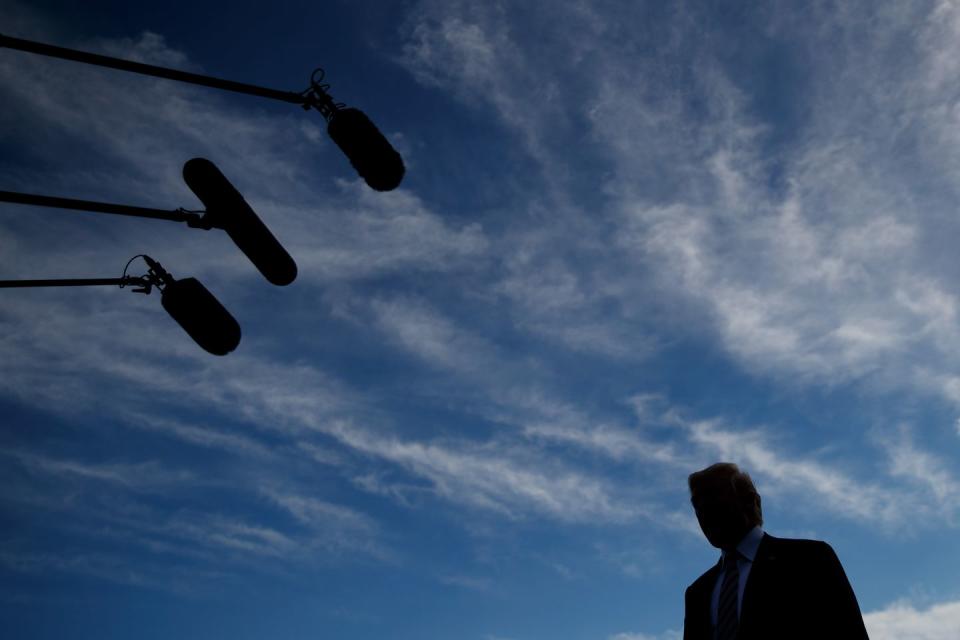
A Secret Service agent strode over to stand next to the group, and soon enough the President of the United States was walking across our field of vision and onto the tarmac of the path where we all stood. He glanced at the group, put a hand up to chest height for a side-wave, and did not break stride along his line 20 yards parallel to the rope chain. “Mr. President,” members of the press corps started calling out. “Mr. President, come on over and chat!” But he was away now, on the South Lawn grass, and some of the biggest political journalists in America realized they’d waited outside for two hours in the sinking cold to get snubbed. “Sir, how do you respond to Nancy Pelosi’s accusation that you committed bribery?” someone called out over the blare of Marine One, still holding out hope for a soundbite.
Trump did another half-wave, and then he was really on his way across the grass. The besuited aides who were accompanying him to his rally in Louisiana that night came streaming out of the White House behind him. The press moved to another area of the rope-chain to get a better look as the rotors started going and, after a couple minutes of freezing wind, the chopper rose to take off. It swung 90 degrees and then started off towards the southern end of the White House grounds again, over the fountain and past the Washington Monument until it was eclipsed by the blue-pink sky.
“Can’t believe he didn’t come over for that ‘bribery’ one,” somebody said as we filed back inside. The White House press corps couldn’t help but laugh.
You Might Also Like

